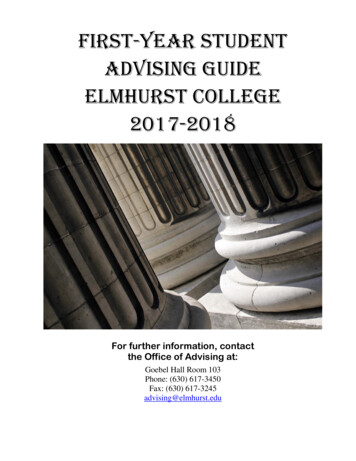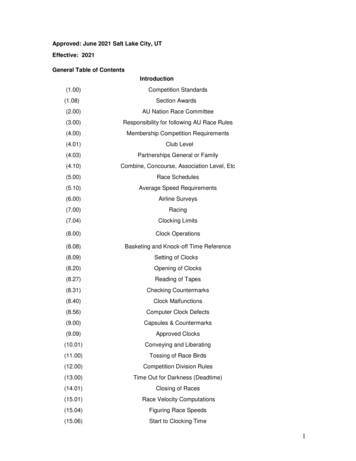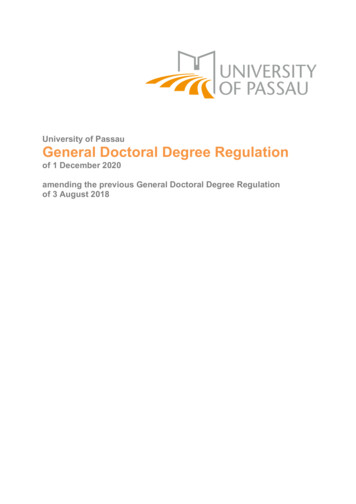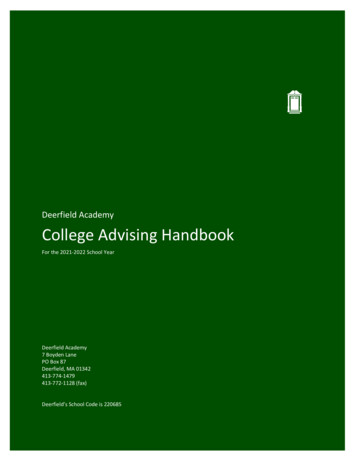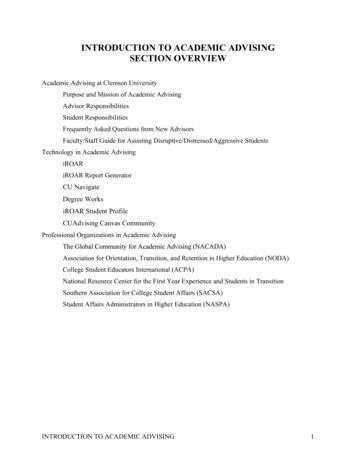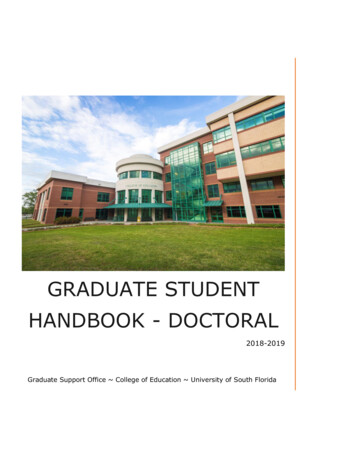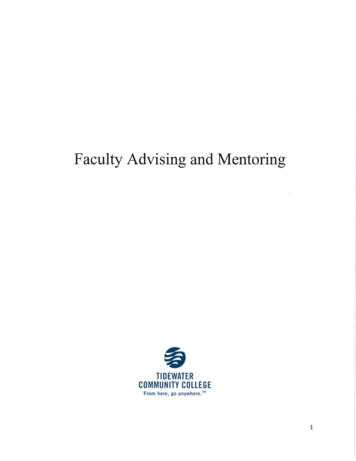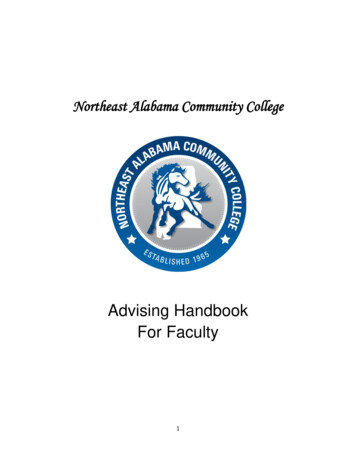
Transcription
Innovations in Education and Teaching InternationalISSN: 1470-3297 (Print) 1470-3300 (Online) Journal homepage: https://www.tandfonline.com/loi/riie20Racial context, currency and connections: Blackdoctoral student and white advisor perspectiveson cross-race advisingMarco J. BarkerTo cite this article: Marco J. Barker (2011) Racial context, currency and connections: Blackdoctoral student and white advisor perspectives on cross-race advising, Innovations in Educationand Teaching International, 48:4, 387-400, DOI: 10.1080/14703297.2011.617092To link to this article: hed online: 18 Oct 2011.Submit your article to this journalArticle views: 508Citing articles: 13 View citing articlesFull Terms & Conditions of access and use can be found ation?journalCode riie20
Innovations in Education and Teaching InternationalVol. 48, No. 4, November 2011, 387–400Racial context, currency and connections: Black doctoral studentand white advisor perspectives on cross-race advisingMarco J. Barker*Diversity & Community Outreach, Louisiana State University, Baton Rouge, LA, USAIn the higher education context of the United States, in which Blacks have hadthe most significant increase among other ethnic minority groups, this articleexplores the cross-race advising relationship between Black doctoral studentsand their White advisors. Through examining congruence in faculty advisors’and their student protégés’ perspectives on race, we find: (1) the role of race incontext; (2) race as leverage and/or liability; and (3) the importance of samerace connections emerged as important issues: each has implications for doctoralstudent persistence and retention, faculty development, and graduate advisingand mentoring. The implications of these findings extend beyond the US toother international systems of higher education where there is a growing interestin the increased diversity of doctoral students and the cross-cultural or cross-ethnic relationship between student and advisor/supervisor.Keywords: cross-race advising; doctoral education; US graduate educationIntroductionObtaining the doctorate is no easy task. Only 1% of people 18 years and older inthe United States (US) hold doctoral degrees (US Census, 2003). Of those withdoctoral degrees, Blacks1 comprise only 3.5% of doctoral degree holders (US Census, 2003). Although there has been an increase in the number of Blacks enrollingin US doctoral programs (Cook & Cordova, 2006), doubling between 1994-95 and2004-05, Nettles and Millett (2006) found that Blacks and Latinas/os have higherattrition rates compared to Asian American, international, and White doctoral students. Similarly, national organizations (e.g., Carnegie Foundation, Lumina Foundation, Southern Regional Education Board, and Woodrow Wilson NationalFellowship Foundation) have brought greater attention to the need to examine diversity and the PhD. In their report, the Woodrow Wilson National Fellowship Foundation (2005) calls for a thorough examination of programs designed to increase thediversity of students pursuing doctoral degrees. This attention is in response to thelow representation (7%) of Black and Hispanic students in doctoral programs compared to significant representation (32%) of Blacks and Hispanics in the US population of doctoral age (Woodrow Wilson National Fellowship Foundation, 2005).Whereas Blacks have the highest level of enrollment, compared to other underrepresented ethnic minorities (Cook & Cordova, 2006), but yet a higher rate ofattrition (Nettles & Millett, 2006), a greater examination of Black doctoral student*Email: mbarke1@lsu.eduISSN 1470-3297 print/ISSN 1470-3300 onlineÓ 2011 Taylor & 092http://www.tandfonline.com
388M.J. Barkerexperiences is warranted. Although there have been some studies that examineBlack doctoral students and White faculty perspectives (Gasman, Gerstl-Pepin,Anderson-Thompkins, Rasheed, & Hathaway, 2004), there is a lack of in-depthresearch on the cross-race advising relationship from dual perspectives.The purpose of this study was to examine the role of race in cross-race advisingrelationships between White faculty advisors and their Black doctoral student protégés at an American institution in the South. Higher education of Blacks in theAmerican South has a unique history of racial segregation and cross-race tension(Anderson, 1988, 2003; Watkins, 2001). The history of race and education in theSouth is one of exclusivity, racism, and interest-convergence (Altbach, Lomotey, &Rivers, 2002). To study the phenomenon of cross-race advising in doctoral education, I posed the following research question: How does race impact the advisingrelationship between Black doctoral student protégés and their White facultydvisors?Literature and theoretical frameworksThe literature on the phenomenon of cross-race doctoral advising can be organisedinto three overarching themes: (a) doctoral education and advising; (b) the experiences of doctoral students of color; and c) White faculty considerations.Doctoral education and advisingUS doctoral education presents a unique set of academic requirements, milestones,and cultural cues that may be ambiguously communicated or understated. Completing the doctorate consists of a system of complex social and academic integrationprocesses (Gardner & Barnes, 2007; Golde, 2005; Lovitts, 2001; Tinto, 1975) with‘common’ milestones, which Walker, Golde, Jones, Bueschel, and Hutchings (2008)identified as ‘course taking, comprehensive exams, approval of the dissertationprospectus, the research and writing of the dissertation, and the final oral defense’(p. 10). Completing coursework is a prerequisite that is more common in the USthan in the UK, Australia or New Zealand where coursework is not usually requiredprior to conducting research (Green & Macauley, 2007; Lovitts, 2001). However,both American and international systems of doctoral education emphasise the faculty-student advising (or supervising) relationship (Green & Macauley), which isdescribed as the most critical aspect of the doctoral process (Gardner, 2007; Green& Macauley, 2007).In Chun-Mei, Golde, and McCormick’s (2007) study, one student passionatelydescribed the student-advisor relationship as this:It is impossible to overestimate the significance of the student-advisor relationship.One cannot be too careful about choosing an advisor. This is both a personal and professional relationship that rivals marriage and parenthood in its complexity, varietyand ramifications for the rest of one’s life. (p. 263)Cultural dynamics of advising are becoming more salient as graduate schools anddoctoral education become more diversified and diversity is seen as an asset in thegreater workforce (Woodrow Wilson National Fellowship Foundation, 2005).Despite this growing diversity, there is a lack of studies that include an analysis
Innovations in Education and Teaching International389combining faculty-student advising relationship, dual perspectives, and the role ofrace.Experiences of Black doctoral studentsThe growing body of literature supports the notion that Black students in US highereducation have unique experiences that differ from other students of color andWhite students (Allen et al., 2003; Davidson & Foster-Johnson, 2001; Fleming,1984; Fries-Britt & Turner, 2002; Jones, 2001). Although some of the experiencesare consistent for undergraduate, masters, and doctoral students, there are experiences that are specific to graduate students in general (Austin, 2002; Gardner, 2008;Gardner & Barnes, 2007; Golde, 2005; Golde & Dore, 2001; Lovitts, 2001; Nettles& Millett, 2006; Tinto, 1993) and doctoral students in particular (Anderson-Thompkins, Gasman, Gerstl-Pepin, Hathaway, & Rasheed, 2004; Gasman et al., 2004;Holland, 1993; Jones, 2000; Mabokela & Green, 2000; Milner, 2004; Nettles, 1990;Rogers & Molina, 2006; Willie, Grady, & Hope, 1991; Woodrow Wilson NationalFellowship Foundation, 2005).The racial climate for Black graduate or doctoral students may be a reflection ofthe student’s interaction with the institution (Clark & Garza, 1994), department(Davidson & Foster-Johnson, 2001), and individuals (i.e., faculty and other students) (Milner, 2004). According to Nettles (1990), Black doctoral students report agreater sense of racial discrimination than Latino/a and White doctoral students.Robinson (1999) found that doctoral students in predominantly White settingssometimes felt a sense of ‘social estrangement and sociocultural alienation’(p. 124); doctoral students have also reported feeling invisible (1997), isolated(2004), and undervalued (Milner, 2004). These instances lead to Black studentsfeeling as if they must over-perform (Bonilla, Pickron, & Tatum, 1994; Milner,2004) or that their work quality is less than the work quality of Whites (Bonillaet al.), creating a sense of academic vulnerability.White faculty considerationsAlthough working across race has the benefit of providing faculty with increasedcultural exposure (Thomas, Willis, & Davis, 2007), there are key issues that impactthe ways in which it happens. Thomas and colleagues posited that faculty membersof majority groups (such as White faculty in predominantly White institutions(PWI)) may not have an understanding of the ‘educational and non-academic experiences’ of ethnic minority graduate students or lack ‘experience in working indiverse contexts’ (2007, p. 183), an issue raised in the literature on White privilege.McIntosh (2001) defined White privilege as ‘an invisible weightless knapsack ofspecial provisions, assurances, tools, maps, guides, codebooks, passports, visas,clothes, compass, emergency gear, and blank checks’ inherited by Whites (p. 78).Similarly, Wise (2008) posited that ‘to be White is to be born with certain advantages and privileges that have been generally inaccessible to others’ (p. 17). Thomasand colleagues also found that White faculty working across race exhibited culturalanxiety, which could prevent them from providing feedback for fear of culturallyoffending the student. In this sense, cultural anxiety may be a result of White faculty working through their own racial identity. Additionally, faculty may not havethe expertise on race as subject matter when working with students of color who
390M.J. Barkerare studying race. Unfortunately, regardless of research interests, faculty may alsobe more inclined to choose a protégé that reminds the faculty member of himself orherself (Thomas et al., 2007).The apprentice mode of research student’s learning from faculty has served as amodel for graduate education for many years (Gruber, 1975). Because advisors playan important role in the doctoral student’s experience and persistence (Lovitts, 2001),and race of student and advisor may further impact the doctoral student’s experienceand persistence (Nettles, 1990; Patterson-Stewart, Ritchie, & Sanders, 1997), a deeper understanding of the intersection of doctoral student advising and race is needed.To bring greater attention to this dynamic, I examined the cross-race relationshipbetween White faculty advisors and their Black doctoral student protégés.Theoretical frameworksThe first overlapping frameworks, Tinto’s (1993) and Lovitts’ (2001) theories ofdoctoral student persistence, provide a lens for contextualizing the doctoral studentexperience, emphasizing how the student’s personal background and other experiences impact the faculty-student relationship and overall persistence. The secondframework, Goto’s (1997) adaption of Triandis’ (1992) cross-cultural interactionconceptual model, provides a lens through which to understand the ways that people of different cultures process cultural differences in order to interact across thosedifferences. In this work I bring these theories to bear at the point where advisorand student interaction is most prevalent: after coursework and before completion.Critical race theory (Ladson-Billings & Tate, 1995) and understanding whiteness asa property – i.e. as ‘a right, not a thing’ (Harris, 1995, p. 1725) – provided otherlenses through which I sought to better understand the racialised contextual influences and the personal, cultural perspectives of both faculty and student.Methods and data sourcesTo study cross-race advising in doctoral education, I posed the question: How doesrace impact the advising relationship between Black doctoral student protégés andtheir White faculty advisors at an American University? To gather and interpret thedata, I used a qualitative phenomenological method: Patton (2002) identified onecentral theme and purpose of phenomenology: ‘a focus on exploring how humanbeings make sense of experience and transform experience into consciousness, bothindividually and as shared meaning’ (p. 104).The sample included Black doctoral students at one research-extensive (McCormick, 2001) PWI in the American South. Student participants had completed atleast two years of coursework, identified as Black or African American, had aWhite faculty advisor, and attended the institution. Compared to students just beginning their program, students who have completed at least half of their courseworkare closer to working with faculty along the doctoral education stages of persistence(Lovitts, 2001; Tinto, 1993). Faculty participants were doctoral student advisorswho identified as White or Caucasian, advised a Black doctoral student, and wereemployed at the institution. Both faculty and student participants granted me permission to interview the other. The final sample resulted in eight White facultymembers and eight Black doctoral students but only seven complete cross-race pairsfor a total of 14 matched participants.
Innovations in Education and Teaching International391Because disciplines represent their own ‘cultural phenomena’ comprising ‘codesof conduct, sets of values, and distinctive intellectual tasks’ (Becher, 1981, p. 109),and disciplinary practices impact the ways in which students and faculty membersinteract (Golde, 2005; Lovitts, 2001), I attempted to remain within the broad disciplinary arena of the social sciences and humanities. I interviewed all 14 participantsfor between 60 and 90 minutes, utilizing a standardised open-ended interviewprotocol.To arrive at the analysis presented here, I performed a specific constant comparative method for dual pairs (Boeije, 2002) and phenomenological reduction. I established relevant themes and triangulated data within and between interview groupsand pairs using Moustakas’ (1994) phenomenological reduction and bracketing.Additionally, I employed Milner’s (2004) Framework of Researcher Racial and Cultural Positionality, which allowed me to consider my own racial experiences in relation to participants, the participants’ racial positions, and racial saliency andrelevance within my study’s context.FindingsThree constructs emerged as cross-group areas of comparison:2 (a) the context ofrace; (b) race as currency; and (c) the importance of racial connections. Anoverview of the cross-group comparison is shown in Table 1.The context of raceFor approximately half of the faculty and students, the American South and the history of race relations in America tended to invoke an emotion and shaped the waythey viewed American society, institutions, geographic regions, and policies. TheAmerican South in this context is representative of the US states that were part ofthe confederacy, where slavery was highly regarded and there was reluctancetowards racial desegregation (e.g., Arkansas, Florida, Mississippi, South Carolina,and Texas) (Anderson, 1988). Both students and faculty made comparisons betweenthe South and non-South. One example of this phenomenon included a facultyTable 1. Cross-group comparison grid.Areas of ComparisonStudentsFacultyContext of Race: There’sa uniqueness of beingin the SouthRace as Currency: Raceis either a liability orleverageCongruence: Students from theNorth felt the South presentedinteresting dynamics of raceRace is liability: Students feltfeelings of isolation and beingundervalued and did notidentify ‘benefits’ of beingBlackImportance of RacialConnections: Samerace connections areimportantCongruence: Students valuedsame-race peers and mentorswho ‘shared’ their experienceas a Black doctoral studentCongruence: Faculty from theNorth felt the South presentedinteresting dynamics of raceRace is both leverage andliability: Faculty felt theirstudents’ race was both anadvantage for the academic jobmarket and a liability, as beingseen as a ‘diversity hire’Congruence: Faculty felt itwas important for students tohave same-race mentors
392M.J. Barkermember who commented, ‘I spent my graduate career . . . in the North . . . and Ithink it’s been interesting to see how race plays out differently in different places.’Whereas one student shared:At [my previous institution in the North], like I said, people . . . you know . . . people[didn’t] really like Black people or they [had] problems with racism, but they reallyjust kept to themselves . . . kept their comments to themselves . . . you know, very covert racism. But here, it’s more overt. People don’t mind expressing their opinion, youknow, just by the way people treat you. They’re just more out with it.Another student noted that, of those persons living in the South, there were starkdifferences between persons who were born and raised in the South versus thosewho were born in the North or were from another country. Reflecting on the positive interactions with her advisor and connection between geography and racialinteractions, this student noted:So, I think that has a lot to do with my advisor’s interactions with me. . .with my advisor not being “from” here versus people that grew up here. I’m not saying they’re racist [referring to people who grew up here], but you know, I’ve noticed a lot ofdifferences with people that are from the South versus people that are from the Northand like other countries as well.Faculty and students who were not born and raised in the South found theSouth, in general, and the state, in particular, to be much more racist compared totheir previous, non-southern residency. Both faculty and students had experienceswith racism either directed at them (doctoral students) or had observed conversations where racial discrimination was practiced by Whites (faculty and doctoral students). While the participants did not discount that racism existed in the North, theybelieved that the South and the Deep South presented greater opportunities for racist occurrences and opportunities.Students and faculty members contended that context played a role in the manifestation of race. Further, they provided examples of how the South carried aunique history of racism and how the history of race emerges in their current lives.The congruent thoughts of both faculty and students suggest that where you studyor where you work is influenced by race (Altbach et al., 2002). White faculty advisors and Black doctoral students within a racialised context may bring these experiences and notions to the advising relationship and, for both, these feelings carry thepotential to impact their advising relationship.In order to promote positive cross-race interactions, I suggest that it isextremely important for faculty and students, particularly those who operate inracially complicated contexts, to have a shared understanding of the racial andcultural history of their context. Faculty and students who share a similarlyperceived history of race have a greater likelihood of positive cross-culturalinteractions (Goto, 1997). Positive interactions would therefore assist facultyand students in forming stronger connections throughout the doctoral studentprocess (Golde, 2005; Guiffrida, 2006; Lovitts, 2001; Tinto, 1993). Furthermore, the history of racial conflict may serve to provide White faculty withhistorical counter-narratives or perspectives on the racial inequity and racistpractices that Blacks in America did and do experience (Ladson-Billings &Tate, 1995).
Innovations in Education and Teaching International393Race as currencyCurrency in this study referred to social value placed on one’s race. Race as currency was categorised as either leverage (a benefit) or liability (a disadvantage).The role of race as leverage was a perspective mostly shared by faculty in comparison to students. Some of the advisors identified their doctoral student’s race as anasset when discussing entering the faculty ranks or applying for fellowships. Thesefaculty members held that their doctoral students would have an added advantagebecause they were Black, in addition to their academic preparedness. Some otherfaculty, however, saw the race of their doctoral student as a liability to the student.For example, they were concerned that their students would not be taken seriouslyor would be questioned based on their race. One faculty member reflected:I guess my fear is that people will not realise how qualified [my doctoral student] iswhen she gets there [being a faculty member] . . . some people will assume off the batthat she got the job because of her race . . . and not even bother to look and realisethat she’s also very qualified and that’s why she got the job. And I don’t know. . . theunknown in that . . . I don’t know how to, I haven’t lived that.Conversely, the doctoral students perceived their race as only a liability and notas benefiting their academic pursuits. One noted:Because for me, it’s more like . . . honestly, I feel like I have so much more to provethan a student from a majority race. I feel like there’s more eyes on me to see howlong it [will] take me to finish, and what my grades were like in school, and what mydissertation [is] going to be like because of stereotypes and things like that.For most of the students, being Black meant preparing to operate in a predominantly White context, managing negative racial experiences, being a salient objectamong students and faculty, and feeling the need to outperform their White peers.Experiencing racism and having to prove oneself echoed through the experiences ofthe doctoral students. These feelings are consistent with the literature on Black doctoral students and the level of racial hyper-surveillance reported by Blacks whooperate in predominantly White spaces (Milner, 2004; Milner, Husband, & Jackson,2002; Patterson-Stewart et al., 1997; Sligh-DeWalt, 2004; Willie et al., 1991; Winkle-Wagner, Johnson, Morelon-Quainoo, & Santiague, 2010).Between the two groups, faculty members viewed race as both leverage and liability whereas Black doctoral students only discussed race as a liability. There areseveral possible reasons for these differences. One may be that faculty were void ofcounter-narratives such as those that might be told by Black faculty and so thereforewere only operating through a privileged lens. Ladson-Billings and Tate (1995)urged educators to rethink the racial history of education and what have been andare the experiences of ethnic minorities. Compounding these White-centered histories is interest convergence (Harper, Patton, & Wooden, 2009; Ladson-Billings &Tate, 1995). These faculty members may be part of departments where interest convergence is dominant – departments bolster diversity not because it is the rightthing to do, but because there is a reward for building a diverse department.Another potential reason for these differing opinions may be that the facultyparticipants are in a place of privilege and power (Villalpando & Delgado-Bernal,2003). They have the option to promote diversity or be seen as someone who‘pushes’ (Gasman, 2010, p. 250) diversity through action or representation; no-one
394M.J. Barkerwill see them as diversity hires. In contrast, the Black doctoral student is alwaysthe salient object; their skin color eliminates the option of not being seen as a diversity or minority hire. These differing standpoints may have an impact on the overalladvising relationship and how faculty direct or advise doctoral students becauseadvisors’ perceptions have an influence on the way they interact with students(Lovitts, 2001). Disconnects in philosophies can therefore lead to disconnects inadvising.This finding suggests the need for additional dialogue on racial differences andan understanding of the social pressures faced by Black doctoral students in comparison to their White counterparts. Faculty in the study exhibited some sensitivityto the racist experiences that students may face entering the workplace but theymay be unaware of the racial nuances that impact currently-enrolled doctoral students. Further, White faculty should be cognizant of the rhetoric used when describing the potential job market for doctoral students of color, not neglecting the largerinstitution of racism that their students must face. White faculty members who aremore aware of these racial nuances may be better equipped with ways to addresstheir student’s feelings. For example, faculty advisors may look for opportunitiesfor their Black doctoral students to engage in research projects in an effort toincrease the level of engagement between the Black doctoral student and the facultyadvisor, peers, and department; increased engagement may, in turn, decrease thelevel of isolation or surveillance felt by the student.Importance of racial connectionsDespite the varying value systems placed on race, it was evident that same-raceconnections were essential. The majority of advisors and students agreed that it wasimportant for Black doctoral students to connect with same-race peers, mentors, orfaculty. However, the same-race connection did not have to be the faculty advisor.In fact, the majority of the Black doctoral students did not specify a racial preference for their advisors, particularly if they had some other type of same-race connection. While some faculty felt these connections were critical, others thought theywere not an essential aspect of the student’s experience but, rather, an added benefit. Additionally, gender emerged as an important area of connection, confirming thework of Maher, Ford, and Thompson (2004). For example, one advisor thought:I would agree 100%. . . that is key for African-American women to have AfricanAmerican women mentors. . . because I see one thing: they have a whole unique perspective and it’s key, but I always figure if there’s no one else, I’m second best . . .but at least, I’m someone who’s reaching out. Yeah, I think it’s critical that they do.This faculty member saw the importance of students having a connection to someone of the same race and gender. Furthermore, she considered herself ‘second best,’articulating a mentoring, racial hierarchy with the same-race was the best firstoption. A few faculty members recognised the need for cultural connections as aneed for greater diversity among faculty ranks and doctoral students. One facultymember discussed how her student’s same-race mentor was often referenced duringtheir conversations and advising meetings. Some faculty expressed the benefits ofhaving diverse faculty for not only Black doctoral students, but also for majoritystudents.
Innovations in Education and Teaching International395The students noted that having same-race peers or faculty as support wasextremely important. For them there was a need to talk with others who understood their experiences as Black doctoral students in a PWI. Tinto’s (1993) andLovitts’ (2001) models indicate the importance of peer connections; however, theseconnections can be enhanced by the cultural factors of the individuals involved(Council of Graduate Schools, 2004, 2009; Gardner, 2010; Johnson-Bailey, Valentine, Cervero, & Bowles, 2009). The students appreciated other students or facultyof color who were able to understand their experiences and validate their feelings.Having a same-race peer to discuss racial issues supports the claim that racismremains a serious issue for universities (Ladson-Billings & Tate, 1995), sinceBlack students found comfort in sharing experiences with other Black studentsand faculty.Overall, both faculty and students shared feelings about the importance of samerace connections. Several advisors facilitated the process of doctoral students connecting with same-race mentors or they were open to students having a same-racementor in addition to the advising relationship. While same-race mentors madesense to the faculty, the faculty members were not familiar with cultural or racialresources that support doctoral students of color. As indicated in the literature(Sligh-DeWalt, 2004), having someone who could share their feelings was important for Black doctoral students.While the students responded that their advisor’s race was not a major factor inadvisor selection, they commented it was essential that advisors who worked acrossrace be sensitive to Black doctoral students’ needs and experiences. The students inthis study valued same-race connections and felt that having this same-race connection was critical to their success.These findings indicate that while it is important to strive for greater diversityamong the faculty ranks and to facilitate the entrance of Black doctoral studentsinto academia, White faculty can still be effective advisors in cross-race relationships. However, the success of having these cross-race relationships relies on thepresence of same-race connections in the lives of students. These same-race orcultural connections must be embraced and welcomed by the White faculty advisor. White faculty advisors need to understand and be sensitive to the role thesesame-race connections serve in understanding the experiences and narratives ofBlack doctoral students. Further, Black doctoral students must be strategic andintentional about identifying positive mentors and allies, same-race and cross-rac
in US doctoral programs (Cook & Cordova, 2006), doubling between 1994-95 and . (Nettles & Millett, 2006), a greater examination of Black doctoral student *Email: mbarke1@lsu.edu Innovations in Education and Teaching International Vol. 48, No. 4, November 2011, 387-400 ISSN 1470-3297 print/ISSN 1470-3300 online 2011 Taylor & Francis

